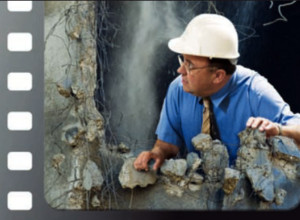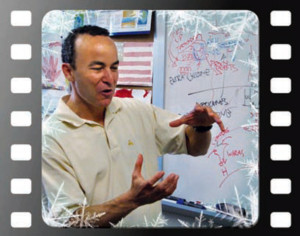Assisted suicide and corporate-driven cannibalism aside, the thing that disturbs Dr. Mark Meisner about the dystopian future portrayed in the 1973 movie “Soylent Green” is the absence of nature in the lives of ordinary people.
“The loss of nature is soul-destroying,” said Meisner, an assistant professor in the Department of Environmental Studies and coordinator of the undergraduate option in environmental communication and culture.
“Soylent Green” depicts a bleak world in 2022: The villains are overpopulation and pollution. The victim is the natural world, which most people have never seen. Meat and produce are available only to the wealthiest people; everybody else survives on processed wafers produced by the gigantic Soylent Corp.
Charlton Heston plays a police detective who investigates a homicide and discovers Soylent Green wafers are made from the flesh of dead humans.
“The movie is meant as a warning,”Meisner said. “It addresses food shortages, global warming and increasing gaps in income, along with that isolation from nature. And, of course, all of these are things that we see in our world now. They are not as extreme as portrayed in the movie, but are present today nonetheless.”
One of the most poignant scenes, in Meisner’s eyes, is when the character played by Edward G. Robinson (in his last movie) discovers what really goes into Soylent Green wafers. In his despair, he chooses euthanasia at a government facility. As he is dying from a fatal injection, he is shown images of an idyllic forest: trees, running streams and animals.
“For 20 minutes, he watches movies about nature,” Meisner said. “It evokes the complete absence of nature from people’s lives. It’s only in death that they have some access to a mediated vision of nature. How sad is that?”
“Soylent Green” exemplifies producers’ attempts to use film to make a point about environmental issues, Meisner said. It’s a film in which scientific accuracy and advocacy are in tension, much like Roland Emmerich’s “The Day After Tomorrow,” which portrays the apocalyptic effects of sudden climate change.
“Did they get the science right? Maybe not,” Meisner said, referring to “The Day After Tomorrow.” “Did they get it right from the point of view of making an exciting movie? Did they get it right from the point of view of raising awareness of the issue? If it raises the issue in the minds of the people, they advanced their goals.”
Meisner, founder and director of the Environmental Communication Network, maintains a filmography of nature and environmental movies on his ECN Web site. At last count, there were nearly 200 movies on it, ranging from “Babe,” featuring a talking pig on a sheep farm, to “A Civil Action,” based on the true story of a Massachusetts town whose water supply was contaminated by pollution.
The environment appears in movies in roles such as villain, savior, victim or obstacle. It can be sentimentalized, as in “Free Willy,” featuring an orca rescued from a shady amusement park owner by a disadvantaged teenager.
“The movie is meant as a warning,” Meisner said. “It addresses food shortages, global warming and increasing gaps in income, along with that isolation from nature.”
There is the nature-as-mutant approach. (See “Prophecy,” page 19) There is the man-vs.- wilderness approach, in movies like “My Side of the Mountain,” based on the Jean Craighead George novel in which a boy from New York City takes off to the Catskills and lives alone in the trunk of an old hemlock.
But, despite the producers’ efforts, do feature films really affect what people think? “We can’t easily say one way or the other,” Meisner said.
Despite the box-office appeal of blockbusters like “The Day After Tomorrow,” which grossed more than $500 million worldwide, Meisner said studies show feature films do not usually have a significant measurable impact on public opinion.
One exception is “The China Syndrome,” the 1979 film that featured a barely contained accident at a nuclear power plant in California.
The movie opened just 12 days before a reactor overheated at the Three Mile Island Nuclear Generating Station, outside Harrisburg, Pa. Compounding the coincidence was a line in the movie that said a nuclear meltdown could “render an area the size of Pennsylvania permanently uninhabitable.”
The movie’s timing amplified the public’s anxiety about nuclear power, Meisner said, and familiarized viewers with some of the terminology used at nuclear power plants.
Although not 100 percent accurate regarding the science of such facilities, the film helped fuel the no-nukes protests of the early 1980s.
For a scientist’s look at some other feature films, read on. But beware: Spoilers lurk.
Share
Staff Favorites:
Fall 2008
‘Soylent Green’ Co-stars Nature in the Role of Victim
‘The Birds’: A ‘Great Movie’ Flies in the Face of Science
Maybe it was a depiction of the revenge of nature or a metaphor for the fear of abandonment. It could have been a comment on the inevitability of chaos or the fragile state of humans’ existence on Earth.
Dr. Guy Baldassarre, an ornithologist in ESF’s Department of Environmental and Forest Biology, has his own take on Alfred Hitchcock’s 1963 masterpiece thriller, “The Birds.” “It’s Al,” he said, putting himself on a first-name basis with the iconic filmmaker. “Al’s great. It’s his imagination.”
Baldassarre’s EFB colleague Dr. William M. Shields considered that Hitchcock might have been warning his viewers to care for the environment, lest the animals unite and strike back. “Even back in the ’60s, Alfred might have been thinking that,” Shields said. “Or maybe he just thought birds looked scary.”
The presence of actual science in “The Birds,” which features mobs of agitated avian creatures inexplicably attacking the clueless residents of a Northern California town, was quickly dismissed when Baldassarre, ESF’s current ornithology professor, and Shields, who teaches animal behavior, got together to talk about the movie.
“Basically, it’s all hocus-pocus,” Baldassarre said. “They would never attack people.” “Never, ever, ever,” Shields continued. “They are more likely to defecate on people.”
But that doesn’t stop the two educators from admiring Hitchcock’s 119 minutes of menacing gulls and evil-eyed crows: “Great movie, though,”Baldassarre said.
“Hitchcock picked the smartest and dumbest of birds,” Shields said. “Crows are exceptionally intelligent, and sea gulls are extremely stupid. So it’s very interesting that he picked one of each. Or maybe he planned it that way.
I don’t know.”
“What species of gulls?” Baldassarre wondered.
Shields: “California.”
Baldassarre: “Probably.”
Shields: “Not many people distinguish between species of gulls, you know.”
Baldassarre: “I’ve never looked to see if he has different species mixed in there. I don’t think so.”
There is a bit of truth in the movie, they said, but it stretches reality. Both crows and gulls will fly at a human interloper and peck at the person’s  head, but only to protect a nest occupied by live young. And one crow might be seen on a beach near a flock of gulls, scavenging for the leftovers from a vacationer’s lunch, but you won’t see flocks of both species lined up on power lines together, looking sinister.
head, but only to protect a nest occupied by live young. And one crow might be seen on a beach near a flock of gulls, scavenging for the leftovers from a vacationer’s lunch, but you won’t see flocks of both species lined up on power lines together, looking sinister.
Hitchcock’s winged stars went from sinister to downright terrifying, pecking their way into houses so they could aim their beaks at the occupants.
But the only bird that could survive such an attempt is the aptly named woodpecker. The built-in shock absorbers in its head would prevent it from literally beating its brains out on a wooden shingle.
“Take that little bird that doesn’t weigh very much and have it try to peck its way into a house,”Shields said, pointing at a mounted crow he and Baldassarre had brought along for a photo shoot.
“Its brain is going to go bang!, bang!, bang!, bang!, bang! inside its head. That’s called subdural hematoma and death for a crow.”
He gave the film another moment’s thought and concluded: “It’s not inconceivable that a suicidal bird and its compatriots could peck its way into a house and attack people. It’s not inconceivable at all, in imagination. Just in reality.”

Standing in for the California gull of Hitchcock’s Northern California town is a herring gull, borrowed from the Roosevelt Wildlife Collection at ESF. The birds join Guy Baldassarre, left, and Bill Shields.
‘Cars’ Speeds through the Issues to Arrive at a Happy Ending
Disney/Pixar’s animated feature movie “Cars” is about a rookie race car who, through an encounter with the residents of a forgotten town along Route 66, learns there’s more to life than winning races. From an ESF standpoint, it’s also about the revival of a once-prosperous community.
The arrival of Lightening McQueen, the aforementioned race car, to the town of Radiator Springs ultimately results in the town’s rebirth. In reality, it takes more than “a hotshot race car” to revive a town.
In “Cars,” McQueen returns to Radiator Springs and makes it his racing headquarters.
With the race car comes money, resources and tourists. ‘Cars’ ends with a silver bullet, but the CCDR often doesn’t get that,” said Cheryl Doble, director of the Center for Community Design Research. “We have to look at the resources available and build upon that.”
 The CCDR, an outreach program within the Department of Landscape Architecture, works in partnership with communities and other academic programs to provide technical assistance, educational programs and research projects that build a community’s capacity to manage sustainable futures.
The CCDR, an outreach program within the Department of Landscape Architecture, works in partnership with communities and other academic programs to provide technical assistance, educational programs and research projects that build a community’s capacity to manage sustainable futures.
“Radiator Springs’ new life comes as a result of the individual hero coming back,” said Doble.
In reality, revitalizing a town takes many people and much thought. “The residents have to understand what they value, describe the vision that they hold for their community and identify the actions that they can take to achieve their vision.”
Doble notes that “Cars” does accurately portray aspects of life in such towns. Radiator Springs was once a thriving town on the much-traveled Route 66. When the interstate bypassed Route 66 and the towns along the way, those towns began to wither.
Rural villages throughout New York have experienced a similar fate, she said. Once thriving downtowns and Main Streets have disappeared as major highways allow people to travel around towns rather than through them. Doble said this has been particularly true in Northern New York, where cars zoom past towns on the highway, and while the residential core of the community often maintains its integrity, its commercial centers have disappeared with the advent of the highway.
“It (the movie) was interesting because it illustrates a common phenomena; a lot of communities have been bypassed as a result
“The movie is meant as a warning,” Meisner said. “It addresses food shortages, global warming and increasing gaps in income, along with that isolation from nature.”
of new highway construction,” said Doble. “It’s complicated when a community goes through change.” In the case of Radiator Springs, it is a once-prosperous tourist town that hasn’t found a way to recapture its past glory.
“Clearly at one time it (Radiator Springs) was a happening place,” said Doble. “And now in spite of its economic decline, it has an interesting collection of residents that have no intention of leaving.” Doble said a group of die-hard residents is common in such situations.
“People who have lived there all their lives stay. Some — like Sally, the Porsche — come to get out of the rat race and are able to find the beauty of the place and try to stimulate something to happen. Others, like Mater the tow truck or Flo the show car, stay out of loyalty.
“This is something we see a lot of with the CCDR,” said Doble.
Doble said a former student once did a study of a rural community, like Radiator Springs, and often found “people who had lived there for years and feel a real sense of loss. The empty storefronts and boarded-up homes were hard for them to accept. The study looked at how that sense of loss affects the ability to plan for the future.”
Doble added, “It’s hard to plan for a new future when you want the past to return.”
The fact that the movie was produced by Disney also interested Doble.
“At Disney World and Disneyland they’ve frozen and celebrated the idea of Main Street, and to see Disney present a movie that portrays the loss of the vitality, and then revival, of a main street is interesting.”



 Much like a human drama queen, the mansion that stars in “The Money Pit” overacted a bit. But despite the old house’s histrionics, one of ESF’s resident construction experts said the basic premise of the 1986 comedy was realistic.
Much like a human drama queen, the mansion that stars in “The Money Pit” overacted a bit. But despite the old house’s histrionics, one of ESF’s resident construction experts said the basic premise of the 1986 comedy was realistic. “The movie was dramatically exhilarating!” said Dr. Theodore Endreny about “The Day After Tomorrow.” And what it lacks in meteorological accuracy it makes up for in special effects as climatologists race to save as much of North America’s population as possible before an abrupt climate shift ushers in a new ice age.
“The movie was dramatically exhilarating!” said Dr. Theodore Endreny about “The Day After Tomorrow.” And what it lacks in meteorological accuracy it makes up for in special effects as climatologists race to save as much of North America’s population as possible before an abrupt climate shift ushers in a new ice age. “Prophecy,” a nature’s revenge tale from 1979, hits all the high points: big business polluting the waterways, a clash between cultures, commentary on reproductive rights, the plight of the poor and, of course, a mutant she-bear terrorizing a small Maine town.
“Prophecy,” a nature’s revenge tale from 1979, hits all the high points: big business polluting the waterways, a clash between cultures, commentary on reproductive rights, the plight of the poor and, of course, a mutant she-bear terrorizing a small Maine town.